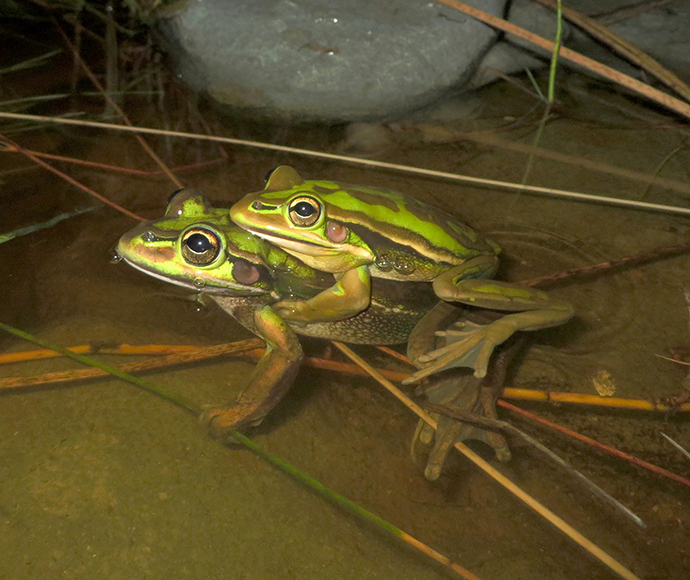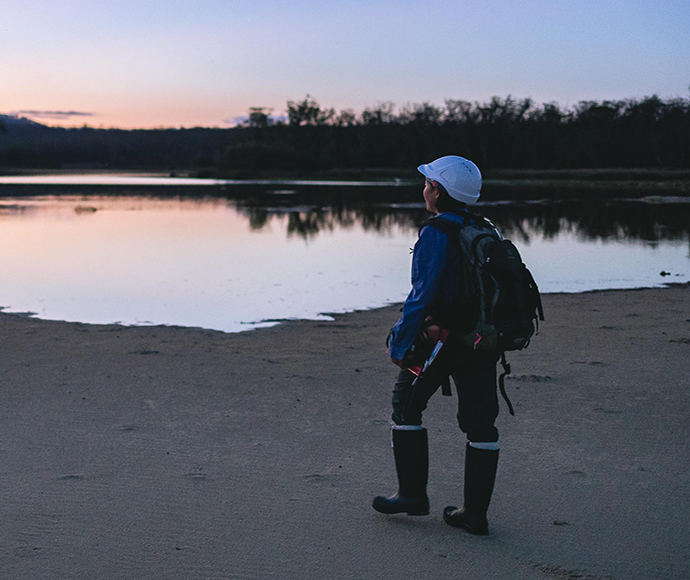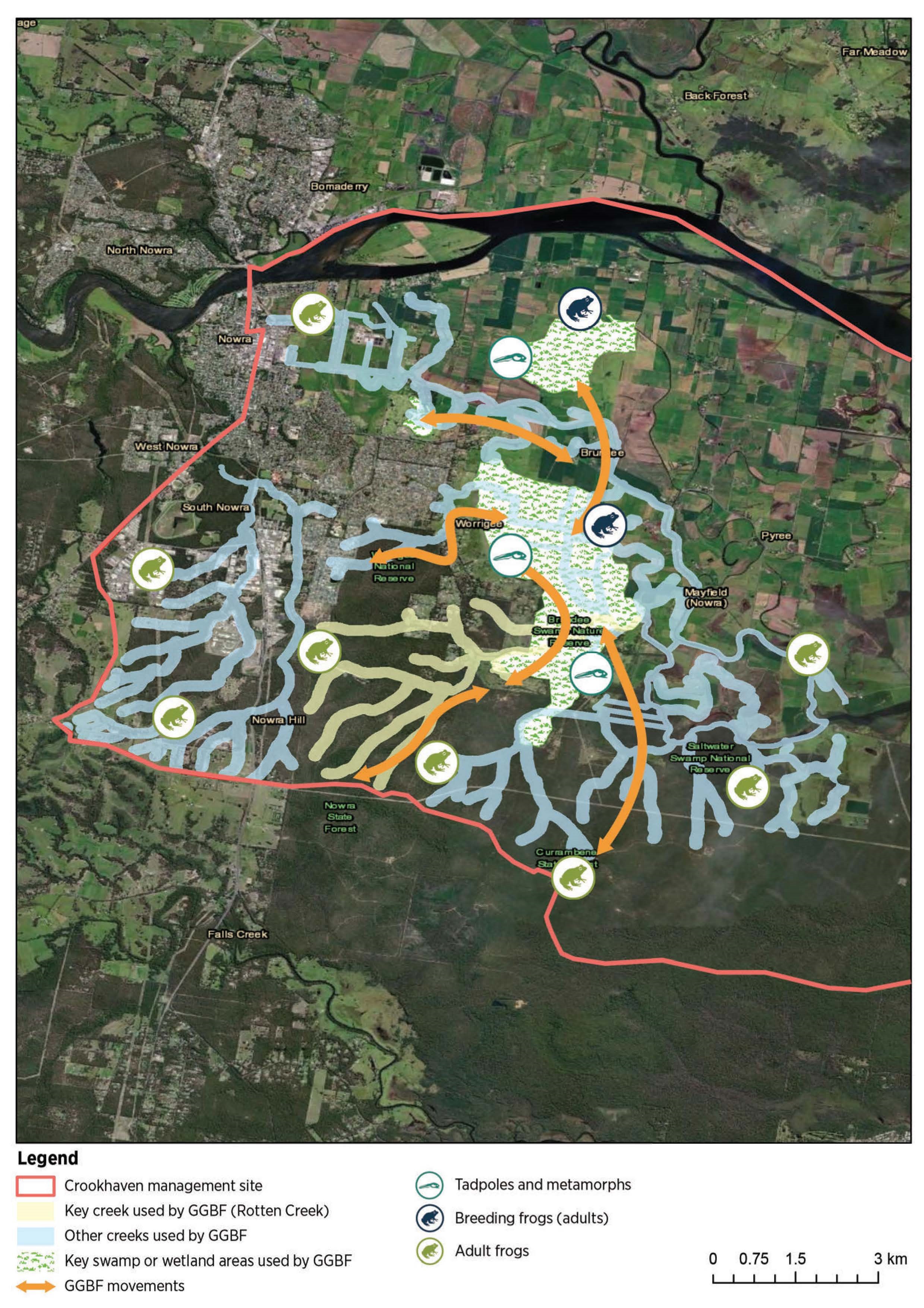Guardians of the Green and Golden Bell Frog
The motorbike-like call and bright and bold colours of the green and golden bell frog make it one of Australia’s most distinctive frog species. Unfortunately, this frog is endangered and needs your help!
A little over 10 years ago, green and golden bell frogs (GGBF) were recorded in the thousands around Nowra across the Crookhaven floodplain. Data over the last nine years has shown the numbers and distribution of frogs in this population have crashed! Frogs are now present in low numbers and are restricted to the large swamp areas around Terrara and Brundee Swamps and wetlands and creeklines near these swamps.
The GGBF lives right on our doorstep, so we’re asking the community to be our eyes (or rather ears) on the ground to help us find out where this frog is living. Do you have what it takes to be a Guardian of the Green and Golden Bell Frog?
We need your help!
The Department of Planning and Environment is coordinating a community-based citizen science GGBF survey and monitoring program, where we’re asking community members to help us survey and monitor GGBF. The data you collect will help us plan and prioritise our conservation work, and may help us detect any changes in the distribution of GGBF across the Crookhaven floodplain, as community members can survey areas outside of our formal monitoring program.
How to join the Guardians of the Green and Golden Bell Frog

2. Login to your FrogID profile through a web browser such as Google Chrome (not through the app).
3. Under the ‘my group’ tab, you can search for and join the Guardians of the Green and Golden Bell Frog group.
Surveying for the GGBF is simple – visit GGBF habitat and use the free FrogID smartphone app to record any frog calls you hear. Experts at the Australian Museum will then listen to your recordings and identify the species present. You don’t need to disturb the frog or its habitat to make a submission through the FrogID app.
Important: Please follow safe frogging guidelines, such as cleaning and disinfecting footwear, tyres and equipment between frog habitats, to reduce the risk of disease spread. Do not touch frogs. Detailed information on hygiene protocols can be found in our Hygiene guidelines.
If you don’t hear the frogs, but see them, submit images to FrogID
While the FrogID app is focused on frog calls, our partnership with the Australian Museum allows images to be submitted via the FrogID app.
Please follow these steps to submit images of non-calling GGBFs, being careful not to disturb the frog or its habitat:
- Record a minimum of 20 seconds of audio.
- Select filters, including No frogs calling, then select Next.
- Select Photos to attach photo of frog.
- Select Notes to add any comments.
- Select Submit.
How to survey the green and golden bell frog
GGBFs can be found around the edges of a wetland in fringing vegetation, to maybe 20m away from the edge. They might be slightly off the ground, on the roots of trees or logs, and in vegetation. Searches can be as little as 5–10 minutes for small wetlands/dams, but more time should be spent at larger wetlands. Half an hour would be fine for most scenarios, but feel free to stay out longer if you’re enjoying yourself! You only need to record frog calls with the FrogID app for a minimum of 20 seconds to contribute to the project.
When to survey
The best time to find the GGBF is October/November to March, but this does vary from year to year. If it is warm in late winter, the frogs may be active as this can break torpor, a hibernation-like state the frogs enter over winter.
Time of day and weather
You can find GGBFs at any time during their active period; however, rain, temperature and time of day do influence their activity. It is best to listen from dusk to midnight, after rain (within a week of heavy rain) on warm, calm nights. GGBF can also be seen during the daytime basking in the sun, as they have special skin properties that prevents them from drying out, so still, sunny and warm (above 20°C) days may be a good bet!

Where to survey
GGBF are found in a range of habitat types, including marshes, dams and stream sides (but not fast-flowing streams), and even very disturbed areas like quarries, sewage treatment plants or near urban developments.
For preferred habitat, they like waterbodies that have:
- good emergent aquatic vegetation cover, but are not choked up with vegetation
- unshaded wetlands, with a grassy area and daytime sheltering areas (rocks, logs, grasses). The aquatic reed known as Cumbungi is preferred by the Crookhaven GGBFs.
How often to survey
As often as you are comfortable to! FrogID welcomes recordings every day if possible, even if it is the same frog calling from the same wetland each day. As mentioned, warm evenings after rain are usually great conditions to listen out for frogs. Don’t forget to follow safe frogging guidelines!
Send us extra useful information
Frog ID will record much of the important information for us; however, if you would like to make a comment with your submissions, additional info that is helpful includes: weather conditions, a description of water body, any general comments, and if any mosquito fish are seen.

Green and golden bell frogs move into the key swamps and wetlands in the active season (October to March) to breed.
As shown on the map, tadpoles and metamorphs develop in these key swamps and wetlands. Adults, in particular females, retreat to the upper tributaries of Rotten Creek and Crookhaven River for the winter.
Why populations are declining in the wild
The decline of the green and golden bell frog, and many other frog species throughout the world, is primarily due to a disease caused by infection with a frog-specific fungus. The amphibian chytrid fungus Batrachochytrium dendrobatidis is a newcomer to Australia and many frog species have limited resistance to the disease it causes.